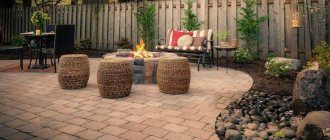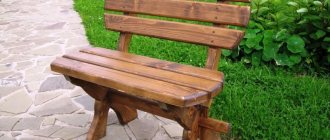In a garden plot where there is a stream of natural or artificial origin, small bridges with walking paths are usually installed. This element gives the site a zest. The drawings of a decorative garden bridge and step-by-step instructions with photos presented in the article will help you make a structure for your dacha and garden with your own hands.
A small wooden bridge over a stream on the site
Landscape Design Ideas
A bridge on a garden plot should be considered as a decor that complements the appearance of the plot. Its functional purpose is revealed only when it is used to make terrain areas passable, and this rarely happens in gardens. That's why design matters.
- The presence of such decor makes a much greater impression on the audience than figurines, garden figurines, etc. And if it is combined with an artificial pond, then the garden becomes a real fairy tale (read our article on how to make a beautiful pond in your country house).
The path runs through a small ravine - the bridge made the crossing safe
- Due to the shapes and materials from which the bridge is made, you can completely transform the perception of the area on which it is installed. Its structure becomes more complex and visual space is added.
- Of course, without water features it is not easy to fit it neatly into the garden, but it is possible if you follow simple tips.
Wet or "dry" stream
It is worth noting that it is not necessary for a river to flow through its six to ten acres or for there to be a lake with an island in order to throw bridges across them. We will show you how to effectively complete a romantic landscape without them with a wooden bridge only three to five meters long.
Even on the so-called “dry stream” it will enliven the entire area, children will especially be happy with it. And it will make an indelible impression on the whole family and friends. Let us present to the attention of the same lovers of novelty photos of bridges for a summer residence.
Where to install a garden bridge
It is clear that there is no point in placing a bridge on a flat surface. This will only cause confusion on the part of visitors to your garden. Such a bridge will simply look “parked”, just getting ready for installation. To avoid this effect, it is necessary to provide at least a semblance of an impassable area. It can be created by digging a trench, running an artificial stream, or installing decorations made of natural stone and vegetation.
Do-it-yourself pile of stones
- If there are differences in relief on the site, then consider yourself lucky - it will be enough to decorate them correctly, and the bridge will definitely not look like an alien object.
- They say that bridges are only good for large areas, but this is not true. If you draw up the layout of the territory correctly, choose a model of small dimensions and properly decorate it, even in a small area it will look advantageous (read about the landscape design of a small area in the article). For example, at a dacha, a small bridge can become part of a garden path.
- You can make a dry stream under the bridge. It's not difficult at all - you can plant grass to imitate a waterway, or frame an existing lawn with flowers or natural stone. This idea will definitely enliven a monotonous landscape.
Dry stream - the banks are decorated with flowering plants
- The location of the bridge is of particular importance. Yes, we have already talked about the relief and its features, but this rule is not always followed. The bridge should be visible to people relaxing in the garden, it should be used, which means it should be located on one of the main paths.
- At the same time, they look at the proximity of installed objects. They are often placed near gazebos and verandas (you can see the designs of gazebos with barbecues and barbecues at the link). Thanks to this, the recreation area becomes more picturesque.
In general, there are no specific recommendations, so you need to look at a specific location. Ideally, a landscape design project is drawn up, in which you will see the result in advance.
Construction principles
When building a bridge, maintain proportions. There must be sufficient distance between it and surrounding objects. After all, if you install a small decorative structure next to large trees or garden structures, it will get lost.
The path leading from the bridge should lead to planting trees or flowers. The location of the bridge on one bank, and the flowering island on the other, will advantageously divide the space. The garden bridge itself can also be decorated. Plant a bush of climbing roses or grapes next to it; such an element will add sophistication and romance to the overall picture.
What are garden bridges made of?
The appearance of the structure, not counting the decor and finishing, is largely influenced by the material from which it is made.
Wooden bridges
Wood is a material that can be easily processed. You can use it to build structures of varying levels of complexity, from the simplest in country style to masterfully made carved models.
Straight wooden bridge over a stream
- The appearance of wood can be changed through various treatments. For example, brushed wood looks like it has been worn by time and even fire. Such effects are suitable for different styles.
- The wooden bridge is easy. It does not require casting of “bulls” - it can be installed on a couple of flat stones. For the same reason, the delivery of material to the site is facilitated.
- At the same time, the design is strong if all parts are precisely fitted and securely fastened.
- The best types of wood are ash, pine, larch, oak, and birch. If the structure is thrown over a water barrier, then it is advisable to use rocks that do not deteriorate from moisture.
- If the structure has the shape of a viaduct (curved), laminated wood is used as beams - it does not need to be bent, only a slab is made, from which a part of the desired shape is cut out. Glued laminated wood has high strength and better withstands moisture; it can also be used to create handrails.
- Flooring boards are taken with a thickness of 30 mm to cope with all loads. At the same time, the presence of cracks and falling knots in them is not allowed. Boards are laid with a adjusted gap to ensure unhindered drainage of rain and melt water.
- There are many types of wooden bridges. These are both plank and log structures. The fastening system may also differ - suspended, rigid.
Appearance
The next classification is related to the configuration of the bridges. Based on this, they can be:
- Straight. The simplest option that is suitable for any style. Sometimes they don't even have railings.
- Arched or Japanese. A slight curve and ethnic pattern will be an excellent addition to an oriental garden.
- Stepped. Often installed as a level when connecting banks located at different levels. A distinctive feature is that such bridges have 1-2 steps on one or both sides (depending on the complexity of the terrain).
- Step by step. Such unique “bridges” are used to decorate a “dry stream”. They are made of rounded stones laid in the form of a ford across a river.
- Asymmetrical. One of the most complex designs. It can be made in free form and look like a zigzag structure, arch or other configuration.
Decorative bridge in garden landscape design
15Common Mistakes
One of the mistakes is the awkward appearance of a bridge in a garden landscape. Each type of structure needs an appropriate environment. The site must be zoned, with a smooth transition from one zone to another. A Japanese-style building will not be appreciated unless it creates an aura of peace and balance. Similar requirements apply to other bridge options. The size and shape of the bridge must be correlated with the size of the site. The smaller it is, the simpler the structure and the smaller the bridge should be.
Despite the primary role of a decorative element, the bridge must be reliable and not dangerous. Steps should be made comfortable in width and height. The surface of the flooring should not be slippery. The railings must be made comfortable for support, strong, and aligned with the beginning of the flooring.
How to build a bridge for your summer cottage yourself
Now let's figure out how to build a bridge across a pond with your own hands. Wood will be used as the material, for the reasons already described earlier. Let's look at the whole process, starting with design.
Drawings of a garden bridge
Any design work must begin with drawing up a drawing of the product. It would be nice to make a project, but this applies, rather, to more difficult options. Wooden structures are lightweight, they do not require a separate foundation, although if you need to get a high-quality, long-lasting result, why not.
Example drawing of a simple bridge
You can draw up a drawing yourself, as you can take into account your needs and preferences. You can hire a worker, or simply find a suitable layout online and adjust it to suit you.
Masters graphically depict drawings in 3-D programs. You can also draw everything on paper, the old fashioned way. In this case, the bridge is depicted in two planes so that it is possible to note the dimensions of all important parts.
At this point, think about bridge railings. If children will be walking on it, do not think about horizontal bars and other supports that they can climb up. The distance between the vertical balusters should be made wide if there is no risk of falling down, and 10 cm if there is a danger.
Metal
Metal bridges themselves, especially in the ancient Western European Gothic style, will decorate the site. And also in the mix: a wooden base and forged or cast metal handrails. They are sold in construction supermarkets.
Procedure
After choosing the location for the bridge, markings are made. Its dimensions and location of the bases are determined. The longitudinal axis must be perpendicular to the intersection. For all types of bridges, except all-metal ones, pegs are driven into the ground. They mark the end and beginning of the flight.
Then the piles are installed. The next step depends on the shape of the bridge. For direct flooring, longitudinal logs are attached to them, on which boards are laid. The arc of an arched bridge is obtained by connecting half-arches cut from wood or cast from concrete.
DIY bridge over the river
With the development of civilization, bridge designs became more and more advanced, increasingly differing in their functional purpose. However, wood, as before, remains the most common material for the manufacture of bridges of simple construction. For the independent production of small bridges, wood is an even more irreplaceable material, since it is quite easy to process manually and mechanically, and connecting parts of wooden structures together is not particularly difficult.
CONSTRUCTION OF A BRIDGE WITH YOUR OWN HANDS
With the development of civilization, bridge designs became more and more advanced, increasingly differing in their functional purpose. However, wood, as before, remains the most common material for the manufacture of bridges of simple construction. For the independent production of small bridges, wood is an even more irreplaceable material, since it is quite easy to process manually and mechanically, and connecting parts of wooden structures together is not particularly difficult.











